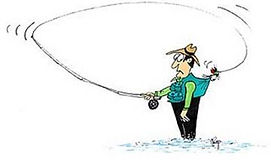My take on fly casting...
Casting, as many...probably most of your know can be, and usually is, the most frustrating part of being a successful fly fisherman. Whether you are stalking a big trout that is holding just on the edge of two currents with a #20 dry fly...or slinging large articulated flies for a 50-100 pound tarpon in the wind...your casting prowess may well determine your success.

Many have described fly casting as an "art form"...in my mind, a beautiful fly caster (the cast...not the person) is indeed a thing of beauty. But the real point of being a good "caster" is not to be "artistic", it is more practical, we want to catch fish...and if you choose to do it with a fly rod, you need to learn how to cast!!
I have known a number of "champion" fly casters" over the years. Two of them are Steve Rajeff and his brother Tim Rajeff. Both Steve and Tim were taught and mentored by the same guy. His name was Mel Krieger. I too spent a lot of time with Mel over the years. He was a friend and he taught me many important things about casting. Steve, Tim and Mel were incredible casters and great anglers. I included the term "great anglers" because not all "champion casters" are good fly fishermen.
Some just cast for the enjoyment and competition. On two occasions, I have fished with another "champion" who will remain nameless...man, this guy could cast a fly line. Problem was, he really had a hard time catching a fish...he was more into showing off his skills. Why cast 100 feet with a perfect tight loop when you can carefully wade close enough to most fish to count their spots...well, almost that close. I guess my point is that it is great to be a beautiful caster but it is even more important to be an effective caster of the fly.
For most of us, fly casting is an ongoing project. Once you have control over the standard overhead cast, there is still a lot more to learn that will benefit you enormously. Let's say you see several nice fish rising 30 feet away...you get into the best position possible position...get ready to cast...look behind you...no room for your back cast. What to do now? Two choices, move to another position (farther away from the fish) or...use the trusty roll cast from where you are. Personally, I believe the roll cast is the second most important cast for the vast majority of fly fishermen.
In this section, I will do my best to explain the many and varied fly casts that exist and their purpose(s). As I have said, I am not a certified casting instructor, I may not a great caster by some standards, I am, however, an effective fly caster under most conditions. Aside from spey and skagit (two-handed rod) casting, I am familiar with and have used most of the types of casts that are important to be a truly successful fly fisherman.
Finally, you should not pay too much attention to all the talk about rod "action"...fast, slow, etc. Once you really understand the principles of fly casting and can put them to practice without thinking too much about them (requires a lot of practice), you will be able to pickup almost any fly rod and, within just a few minutes, cast it well enough to catch fish. Most of the talk about "action", etc. comes from people either tying to sell a new fly rod or just wanting to show off their knowledge. Once you are a proficient fly caster, you may well benefit from a new fly rod with a different action...until then, practice, practice, practice.
